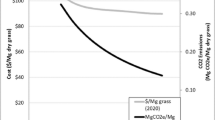Abstract
Short-rotation woody crops (SRWC) could potentially displace fossil fuels and thus mitigate CO2 buildup in the atmosphere. To determine how much fossil fuel SRWC might displace in the United States and what the associated fossil carbon savings might be, a series of assumptions must be made. These assumptions concern the net SRWC biomass yields per hectare (after losses); the amount of suitable land dedicated to SRWC production; wood conversion efficiencies to electricity or liquid fuels; the energy substitution properties of various fuels; and the amount of fossil fuel used in growing, harvesting, transporting, and converting SRWC biomass. Assuming the current climate, present production, and conversion technologies and considering a conservative estimate of the U.S. land base available for SRWC (14 × 106 ha), we calculate that SRWC energy could displace 33.2 to 73.1 × 106 Mg of fossil carbon releases, 3–6% of the current annual U.S. emissions. The carbon mitigation potential per unit of land is larger with the substitution of SRWC for coal-based electricity production than for the substitution of SRWC-derived ethanol for gasoline. Assuming current climate, predicted conversion technology advancements, an optimistic estimate of the U.S. land base available for SRWC (28 × 106 ha), and an optimistic average estimate of net SRWC yields (22.4 dry Mg/ha), we calculate that SRWC energy could displace 148 to 242 × 106 Mg of annual fossil fuel carbon releases. Under this scenario, the carbon mitigation potential of SRWC-based electricity production would be equivalent to about 4.4% of current global fossil fuel emissions and 20% of current U.S. fossil fuel emissions.
Similar content being viewed by others
References
Combustion Engineering: 1981, ‘Chapter 1: Steam Power Plant Design’, in Combustion Fossil Power Systems, Combustion Engineering/Rand McNally, Windsor, CT.
DOE/BMWTD: 1988, ‘Five-Year Research Plan 1988–1992’, U.S. Department of Energy, Biofuels and Municipal Waste Technology Division, DOE/CH10093-25.
Hinman, N. D., Schell, D. J., Riley, C. J., Bergeron, P. W., and Walet, P. J.: 1991, ‘Preliminary Estimate of the Cost of Ethanol Production for SSF Technology’, in Texiera, R. H. and Goodman, B. J. (eds.), Ethanol Annual Report FY 1990, SERI/TP-260–3674, Solar Energy Research Institute, Golden, CO.
Hudson, N. and Mullett, D.: 1987, ‘Wood-Fired Electric Plants and Sound Silvicultural Practices: A Working Formula for Happy Coexistence, as Adopted and Successfully Implemented in the State of Vermont’, internal report, Vermont Department of Forests, Parks and Recreation, Montpelier.
Larson, E. D. and Svenningsson, P.: 1990, ‘Development of Biomass Gasification Systems for Gas Turbine Power Generation’, paper presented at Energy from Biomass Wastes XIV, January 29–February 2, 1990, Lake Buena Vista, FL.
Larson, E. D. and Williams, R. H.: 1990, ‘Biomass-Fired Steam-Injected Gas Turbine Cogeneration’, Biologue 6 (5), 12–19.
Lothner, D. C., Hansen, E. E., and Netzer, D. A.: 1988, ‘Growing and Utilizing Intensively Cultured Woody Crops for Energy: Some Recent Evidence from the North Central United States’, in Lonner, G. and Tornquist, A. (eds.), Proc. IEA Bioenergy, Task III, Activity 4, Workshop Economic Evaluations of Biomass Oriented Systems for Fuel, Swedish University of Agricultural Sciences, Uppsala, Sweden, pp. 92–102.
Lynd, L. L., Cushman, J. H., Nichols, R. J., and Wyman, C. E.: 1991, ‘Fuel Ethanol from Cellulosic Biomass’, Science 251, 1318–1323.
Marland, G.: 1983, ‘Carbon Dioxide Emission Rates for Conventional and Synthetic Fuels’, Energy 8 (12), 981–992.
Marland, G. and Turhollow, A. F.: 1991, ‘CO2 Emissions from the Production and Combustion of Fuel Ethanol from Corn’, Energy 16, 1307–1316.
New Farm and Forest Task Force: 1987, ‘New Farm and Forest Products, Responses to the Challenges and Opportunities Facing American Agriculture’, report to the Secretary, U.S. Department of Agriculture, U.S. Government Printing Office 1987 - 721-254-1302/60251, Washington, DC.
Ostlie, L. D.: 1989, ‘The Whole Tree Burner: A New Technology in Power Generation’, Biologue 5 (3), 7–9.
Ranney, J. W., Barkley, B. A., Turhollow, A. F., and Granger, C.: 1987, ‘Short Rotation Intensive Culture Economics for Energy in North America’, Proc. Int. Energy Agency Workshop on Economic Evaluations of Short Rotation Biomass Systems, August 11–13, 1987, Duluth, MN, USDA Forest Service, North Central Forest Experiment Station, Duluth.
Stokes, B. J., Frederick, D. J., and Curtin, D. T.: 1986, ‘Field Trials of a Short-Rotation Biomass Feller Buncher and Selected Harvesting Systems’, Biomass 11, 185–204.
Turhollow, A. F. and Perlack, R. D.: 1991, ‘Emissions of CO2 from Energy Crop Production’, Biomass and Bioenergy 1, 129–135.
USDA/ERS (U.S. Dept. of Agric., Economic Resources Service): 1989, ‘Agricultural Resources: Cropland, Water and Conservation, Situation and Outlook Report’, AR-16, September 1989, USDA Economic Research Service, Resource and Technology Division, Washington, DC.
USDA/SCS (U.S. Dept. of Agric., Soil Conservation Service): 1987, ‘Basic Statistics, 1982 National Resource Inventory’, Statistical Bulletin Number 756, USDA Soil Conservation Service, Resource Inventory Division, Washington, DC.
USDA/SCS (U.S. Dept. of Agric., Soil Conservation Service): 1989, ‘Summary Report, 1987 National Resource Inventory’, Statistical Bulletin 790, Iowa State Statistical Laboratory. USDA Soil Conservation Service, Resource Inventory Division, Washington, DC.
Wright, L. L., Doyle, T. W., Layton, P. A., and Ranney, J. W.: 1989, ‘Short Rotation Woody Crops Program: Annual Progress Report for 1988’, ORNL-6594, Oak Ridge National Laboratory, Oak Ridge, TN.
Wright, L. L. and Ehrenshaft, A.: 1990, ‘Short Rotation Woody Crops Program: Annual Progress Report for 1989’, ORNL-6625, Oak Ridge National Laboratory, Oak Ridge, TN.
Wright, L. L., Graham, R. L., Turhollow, A. F., and English, B. C.: 1992, ‘Opportunities to Mitigate Carbon Dioxide Buildup Using Short-Rotation Woody Crops’, in Sampson, R. N. and Hair, D. (eds.), Forests and Global Change, Vol. 1, Opportunities for Increasing Forest Cover, American Forestry Association, Washington, DC., pp. 123–156.
Author information
Authors and Affiliations
Additional information
Research sponsored by the Biofuels Systems Division, U.S. Department of Energy, under contract DE-AC05-840R21400 with Martin Marietta Energy Systems, Inc. Environmental Sciences Division Publication number 3952.
Rights and permissions
About this article
Cite this article
Graham, R.L., Wright, L.L. & Turhollow, A.F. The potential for short-rotation woody crops to reduce U.S. CO2 emissions. Climatic Change 22, 223–238 (1992). https://doi.org/10.1007/BF00143029
Received:
Revised:
Issue Date:
DOI: https://doi.org/10.1007/BF00143029




